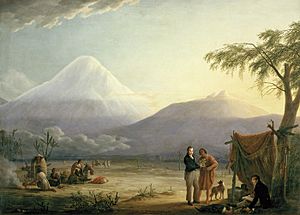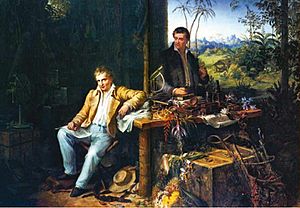Aimé Bonpland facts for kids
Quick facts for kids
Aimé Bonpland
|
|
|---|---|
 |
|
| Born | 22 August 1773 |
| Died | 11 May 1858 (aged 84) |
| Nationality | French |
| Alma mater | University of Paris |
| Known for | Travel with Alexander von Humboldt |
| Parent(s) | Jacques-Simon Goujaud Marguerite-Olive de La Coste |
| Awards | French Academy of Sciences |
| Scientific career | |
| Fields | Physician, biologist, botanist, natural history |
| Author abbrev. (botany) | Bonpl. |
Aimé Jacques Alexandre Bonpland (born August 22, 1773 – died May 11, 1858) was a famous French explorer and botanist. He is best known for his amazing journey with Alexander von Humboldt through Latin America from 1799 to 1804. Together, they explored many new places and discovered thousands of plants.

Contents
Who Was Aimé Bonpland?
Aimé Jacques Alexandre Goujaud was born in La Rochelle, France. His father was a doctor, and Aimé followed in his footsteps. Around 1790, he moved to Paris to study medicine.
While studying, he also became very interested in plants. He attended classes at the Botanical Museum of Natural History. This is where he learned a lot about different types of plants. During this time, he also served as a surgeon in the French army or navy.
Exploring South America
Aimé Bonpland became good friends with another famous explorer, Alexander von Humboldt. They decided to go on a big adventure together! Their journey lasted five years, taking them to many parts of the Americas.
They explored places that are now countries like Venezuela, Cuba, Colombia, Ecuador, Peru, and Mexico. They also traveled along the Orinoco and Amazon rivers. During this incredible trip, Bonpland collected and identified about 6,000 different kinds of plants. Most of these plants were completely new to people in Europe!
When he returned to Paris, he published his findings in a series of books called Equatorial Plants.
Life After the Expedition
After his big trip, Bonpland was given a special payment by Napoleon. This was a thank you for all the plant specimens he gave to the Museum of Natural History.
He also became the person in charge of the gardens at Malmaison. This was the home of Empress Josephine, Napoleon's wife. Bonpland planted many of the seeds he brought back from the Americas there. He even wrote a book about the rare plants grown in these gardens.
New Adventures in Argentina
In 1816, Bonpland decided to move to Buenos Aires, Argentina. He brought many European plants with him. There, he became a professor of natural history.
However, he soon left his teaching job to explore the inside of South America. In 1821, he started a special farm near the Paraná to grow and sell yerba mate. This is a popular tea-like drink in South America.
The area where his farm was located was claimed by two different countries, Paraguay and Argentina. The leader of Paraguay, José Gaspar Rodríguez de Francia, worried that Bonpland's farm would compete with his own business. Because of this, Paraguayan soldiers destroyed Bonpland's farm in December 1821. Bonpland was then held captive in Paraguay until 1829.
During his time in captivity, he was allowed to move around freely. He worked as a doctor for the local people and soldiers.
Later Life and Legacy
Bonpland was finally set free in 1829. In 1831, he returned to Argentina and settled in Corrientes. He was 58 years old. He married a local woman and continued to farm and trade yerba mate.
Later, he went back to Santa Ana and grew orange trees that he had brought to the area. The government of Corrientes gave him a large piece of land to thank him for his work. A small town there is now called "Bonpland" in his honor. Another town in Misiones province is also named Bonpland.
Aimé Bonpland passed away at the age of 84 in 1858.
His amazing collection of plant specimens is kept in Paris at the National Museum of Natural History, France. Many things are named after him, celebrating his contributions to science and exploration:
- The plant group Bonplandia
- The willow tree Salix bonplandiana
- A type of squid Grimalditeuthis bonplandi
- An orchid Ornithocephalus bonplandi
- A lunar crater on the Moon called Bonpland
- Pico Bonpland, a mountain in the Venezuelan Andes
- A mountain in New Zealand
- Streets in cities like Buenos Aires, Argentina, Caracas, Venezuela, and Montevideo, Uruguay.
What Plants Did Bonpland Name?
Aimé Bonpland named or helped describe many different types of plants. Here are some of the groups (genera) and specific kinds (species) he worked on:
Genera
- Abolboda
- Aegopogon
- Alchornea
- Angelonia
- Ceroxylon
- Elionurus
- Eriope
- Espeletia
- Eudema
- Exostema
- Fulcaldea
- Guardiola
- Hypocalyptus
- Isertia
- Leucophyllum
- Limnocharis
- Machaonia
- Matisia
- Menodora
- Pleopeltis
- Retiniphyllum
- Triglochin
- Vauquelinia
Species
- Acacia subulata
- Alchornea castaneifolia
- Arceuthobium vaginatum
- Aristida divaricata
- Arrabidaea chica
- Astragalus geminiflorus
- Banksia marginata
- Brachyotum confertum
- Bertholletia excelsa
- Brugmansia suaveolens
- Brunellia ovalifolia
- Cavanillesia platanifolia
- Centronia mutisii
- Cephalanthus salicifolius
- Ceroxylon alpinum
- Chuquiraga jussieui
- Claytonia perfoliata
- Coriaria thymifolia
- Dorstenia tenuis
- Draba violacea
- Eucalyptus diversifolia
- Eudema nubigena
- Eugenia albida
- Huperzia crassa
- Hydrocleys nymphoides
- Iochroma fuchsioides
- Ipomoea arborescens
- Iresine diffusa
- Jacksonia furcellata
- Juniperus phoenicea
- Lilaea scilloides
- Limnobium laevigatum
- Limnocharis flava
- Ludwigia helminthorrhiza
- Ludwigia sedioides
- Maurandya antirrhiniflora
- Melaleuca pallida
- Miconia caelata
- Miconia guayaquilensis
- Miconia lacera
- Miconia minutiflora
- Miconia theaezans
- Mimosa somnians
- Monochaetum multiflorum
- Passiflora arborea
- Pinguicula moranensis
- Prosopis laevigata
- Prosopis pallida
- Prumnopitys montana
- Quararibea cordata
- Quercus crassifolia
- Quercus crassipes
- Quercus depressa
- Quercus diversifolia
- Quercus humboldtii
- Quercus mexicana
- Quercus obtusata
- Quercus repanda
- Quercus xalapensis
- Smilax havanensis
- Stanhopea grandiflora
- Stanhopea jenischiana
- Styrax tomentosus
- Symphoricarpos microphyllus
- Symplocos coccinea
- Tagetes zypaquirensis
- Theobroma bicolor
- Trichilia acuminata
- Viola cheiranthifolia
- Vitis tiliifolia
- Zieria laevigata
Books by Aimé Bonpland
Aimé Bonpland wrote many important books about his discoveries. Some of his works include:
- 1805: Essai sur la géographie des plantes. This book was written with Alexander von Humboldt.
- 1811: A collection of observations on zoology and comparative anatomy. Also written with Alexander von Humboldt.
- 1813: Description of rare plants grown at Malmaison and Navarre. This book was dedicated to Empress Joséphine.
- 1815-1825: Nova plantarum genera and species. This was a multi-volume work written with Alexander von Humboldt and Karl Sigismund Kunth.
- 1816-1823: Monograph Melastomacées including all plants of this order including Rhexies. This was a two-volume set.
See Also
 In Spanish: Aimé Bonpland para niños
In Spanish: Aimé Bonpland para niños
- Rengger, Johann Rudolph (1795-1832)
- von Humboldt, Alexander (1769-1859)
- Category:Taxa named by Aimé Bonpland


